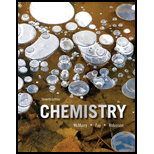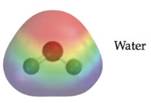
Chemistry (7th Edition)
7th Edition
ISBN: 9780321943170
Author: John E. McMurry, Robert C. Fay, Jill Kirsten Robinson
Publisher: PEARSON
expand_more
expand_more
format_list_bulleted
Concept explainers
Textbook Question
Chapter 7, Problem 7.2A
Conceptual APPLY 7.2 An electrostatic potential map of water is shown below. Which atom, H or O, is positively polarized (electron-poor) and which is negatively polarized (electron-rich)? Is this polarity pattern consistent with the electronegativity values of O and H given in Figure 7.4?

Expert Solution & Answer
Want to see the full answer?
Check out a sample textbook solution
Students have asked these similar questions
shorter than the O-O bond in O2? Explain.
8.37 Which of the following statements about electronegativity is
false? (a) Electronegativity is the ability of an atom in a molecule
to attract electron density toward itself. (b) Electronegativity is
the same thing as electron affinity. (c) The numerical values
for electronegativity have no units. (d) Fluorine is the most
electronegative element. (e) Cesium is the least electronegative
element.
8,38 (a) What is the trend in electronegativity going from
3)
The molecule diphosphorus tetraoxide (P,O,) has two central atoms and four different resonance
structures that do not violate the octet rule. Draw two of these resonance structures below.
4)
The compound acetone is a common solvent. It has a chemical formula of CH,COCH, Acetone has
three central atoms.
(a) Draw the Lewis Dot structure for acetone.
(b) Give the Ideal Bond Angle for all three central atoms.
5)
Four covalent molecules are drawn below.
:o:
H.
H-CH
H
H
(1)
(2)
(3)
(4)
a)
Define each of these molecules as polar or non-polar.
(1)
(2)
(3)
b)
Describe the type of intermolecular force that each molecule would use:
(1)
(2)
(3)
(4)
18.) Choose all the statements that are correct.
(1) Like atomic size, electronegativity decreases going across a period and increases going down a group.
(2) The second most electronegative element is chlorine.
(3) Electronegativity is directly proportional to atomic number.
(4) Like ionization energy, electronegativity increases going across a period and decreases going down a group.
(5) Electronegativity is a measure of the ability of an atom to attract electrons and form a negative ion.
(6) Electronegativity is a measure of the ability of an atom in a molecule to attract electrons go itself.
(7) Electronegativity was first proposed by Linus Pauling.
Group of answer choices
(2)
(1)
(4)
(3)
(5)
(7)
(6)
Chapter 7 Solutions
Chemistry (7th Edition)
Ch. 7 - Prob. 7.1PCh. 7 - Conceptual APPLY 7.2 An electrostatic potential...Ch. 7 - Prob. 7.3PCh. 7 - Prob. 7.4ACh. 7 - Prob. 7.5PCh. 7 - Prob. 7.6ACh. 7 - Prob. 7.7PCh. 7 - Prob. 7.8ACh. 7 - Prob. 7.9PCh. 7 - Prob. 7.10A
Ch. 7 - Prob. 7.11PCh. 7 - Prob. 7.12ACh. 7 - Prob. 7.13PCh. 7 - Prob. 7.14ACh. 7 - Prob. 7.15PCh. 7 - Prob. 7.16ACh. 7 - Prob. 7.17PCh. 7 - Prob. 7.18ACh. 7 - Prob. 7.19PCh. 7 - Prob. 7.20ACh. 7 - Prob. 7.21PCh. 7 - Prob. 7.22ACh. 7 - Prob. 7.23PCh. 7 - Prob. 7.24PCh. 7 - Prob. 7.25PCh. 7 - Prob. 7.26PCh. 7 - Prob. 7.27PCh. 7 - Prob. 7.28PCh. 7 - Prob. 7.29CPCh. 7 - Prob. 7.30CPCh. 7 - Prob. 7.31CPCh. 7 - Prob. 7.32CPCh. 7 - Prob. 7.33CPCh. 7 - Prob. 7.34CPCh. 7 - Prob. 7.35CPCh. 7 - Prob. 7.36CPCh. 7 - Prob. 7.37CPCh. 7 - Prob. 7.38CPCh. 7 - Prob. 7.39CPCh. 7 - Prob. 7.40CPCh. 7 - Prob. 7.41CPCh. 7 - Prob. 7.42CPCh. 7 - Prob. 7.43CPCh. 7 - Prob. 7.44CPCh. 7 - Prob. 7.45CPCh. 7 - Prob. 7.46CPCh. 7 - Prob. 7.47CPCh. 7 - Prob. 7.48CPCh. 7 - Which of the substances...Ch. 7 - Prob. 7.50CPCh. 7 - Order the following compounds according to the...Ch. 7 - Prob. 7.52CPCh. 7 - Prob. 7.53CPCh. 7 - Prob. 7.54CPCh. 7 - Prob. 7.55CPCh. 7 - Explain the difference in the bond dissociation...Ch. 7 - Explain the difference in the bond dissociation...Ch. 7 - Prob. 7.58CPCh. 7 - Prob. 7.59CPCh. 7 - Prob. 7.60CPCh. 7 - Prob. 7.61CPCh. 7 - Prob. 7.62CPCh. 7 - Prob. 7.63CPCh. 7 - Prob. 7.64CPCh. 7 - Prob. 7.65CPCh. 7 - Prob. 7.66CPCh. 7 - Prob. 7.67CPCh. 7 - Prob. 7.68CPCh. 7 - Prob. 7.69CPCh. 7 - Prob. 7.70CPCh. 7 - Prob. 7.71CPCh. 7 - Identify the third-row elements, X, that form the...Ch. 7 - Identify the fourth-row elements, X, that form the...Ch. 7 - Prob. 7.74CPCh. 7 - Prob. 7.75CPCh. 7 - Methyiphenidat (C14H19NO2) , marketed as Ritalin,...Ch. 7 - Prob. 7.77CPCh. 7 - Prob. 7.78CPCh. 7 - Prob. 7.79CPCh. 7 - Prob. 7.80CPCh. 7 - Prob. 7.81CPCh. 7 - Prob. 7.82CPCh. 7 - Prob. 7.83CPCh. 7 - Prob. 7.84CPCh. 7 - Prob. 7.85CPCh. 7 - Prob. 7.86CPCh. 7 - Prob. 7.87CPCh. 7 - Prob. 7.88CPCh. 7 - Prob. 7.89CPCh. 7 - Prob. 7.90CPCh. 7 - Draw two electron-dot resonance structures that...Ch. 7 - Prob. 7.92CPCh. 7 - Prob. 7.93CPCh. 7 - Prob. 7.94CPCh. 7 - Prob. 7.95CPCh. 7 - Prob. 7.96CPCh. 7 - Prob. 7.97CPCh. 7 - Prob. 7.98CPCh. 7 - Prob. 7.99CPCh. 7 - Write an electron-dot structure for chloral...Ch. 7 - Prob. 7.101CPCh. 7 - Prob. 7.102CPCh. 7 - Prob. 7.103CPCh. 7 - Prob. 7.104CPCh. 7 - Prob. 7.105CPCh. 7 - 7.106 Themolecule has nitrogen-oxygen bonds, but...Ch. 7 - Prob. 7.107CPCh. 7 - Prob. 7.108MPCh. 7 - Prob. 7.109MPCh. 7 - Prob. 7.110MPCh. 7 - Prob. 7.111MPCh. 7 - Prob. 7.112MP
Knowledge Booster
Learn more about
Need a deep-dive on the concept behind this application? Look no further. Learn more about this topic, chemistry and related others by exploring similar questions and additional content below.Similar questions
- n your own words, what is meant by the term electronegativity? What are the trends across and down the periodic table for electronegativity? Explain them, and describe how they are consistent with trends of ionization energy and atomic radii.arrow_forwardDefine the term lattice energy. Why, energetically, do ionic compounds form? Fig. 3-8 illustrates the energy changes involved in the formation of MgO(s) and NaF(s). Why is the lattice energy of MgO(s) so different from that of NaF(s)? The magnesium oxide is composed of Mg2+ and O2 ions. Energetically, why does Mg2+O2 form and not Mg+O? Why doesnt Mg3+O3 form?arrow_forwardGiven the bonds C N, C H, C Br, and S O, (a) which atom in each is the more electronegative? (b) which of these bonds is the most polar?arrow_forward
- Acrolein is the starting material for certain plastics. (a) Which bonds in the molecule are polar and which are nonpolar? (b) Which is the most polar bond in the molecule? Which atom is the partial negative end of this bond?arrow_forwardWithout using Fig. 3-4, predict the order of increasing electronegativity in each of the following groups of elements. a. C, N, O b. S, Se, Cl c. Si, Ge, Sn d. Tl, S, Gearrow_forwardWrite all resonance structures of chlorobenzene, C6H5Cl, a molecule with the same cyclic structure as benzene. In all structures, keep the CCl bond as a single bond. Which resonance structures are the most important?arrow_forward
- The two compounds nitrogen dioxide and dinitrogentetraoxide are introduced in Section 3.13.(a) NO2 is an odd-electron compound. Draw the bestLewis diagrams possible for it, recognizing that oneatom cannot achieve an octet configuration. Use formal charges to decide whether that should be the(central) nitrogen atom or one of the oxygen atoms.(b) Draw resonance forms for N2O4 that obey the octetrule. The two N atoms are bonded in this molecule.arrow_forwardAlthough I3- is a known ion, F3- is not. (a) Draw the Lewis structure for I3- (it is linear, not a triangle). (b) One of your classmates says that F3 - does not exist because F is too electronegative to make bonds with another atom. Give an example that proves your classmate is wrong. (c) Another classmate says F3- does not exist because it would violate the octet rule.Is this classmate possibly correct? (d) Yet another classmatesays F3- does not exist because F is too small to make bonds tomore than one atom. Is this classmate possibly correct?arrow_forward
arrow_back_ios
arrow_forward_ios
Recommended textbooks for you
 Introductory Chemistry: A FoundationChemistryISBN:9781337399425Author:Steven S. Zumdahl, Donald J. DeCostePublisher:Cengage Learning
Introductory Chemistry: A FoundationChemistryISBN:9781337399425Author:Steven S. Zumdahl, Donald J. DeCostePublisher:Cengage Learning Chemistry for Engineering StudentsChemistryISBN:9781337398909Author:Lawrence S. Brown, Tom HolmePublisher:Cengage Learning
Chemistry for Engineering StudentsChemistryISBN:9781337398909Author:Lawrence S. Brown, Tom HolmePublisher:Cengage Learning Chemistry: The Molecular ScienceChemistryISBN:9781285199047Author:John W. Moore, Conrad L. StanitskiPublisher:Cengage Learning
Chemistry: The Molecular ScienceChemistryISBN:9781285199047Author:John W. Moore, Conrad L. StanitskiPublisher:Cengage Learning World of Chemistry, 3rd editionChemistryISBN:9781133109655Author:Steven S. Zumdahl, Susan L. Zumdahl, Donald J. DeCostePublisher:Brooks / Cole / Cengage Learning
World of Chemistry, 3rd editionChemistryISBN:9781133109655Author:Steven S. Zumdahl, Susan L. Zumdahl, Donald J. DeCostePublisher:Brooks / Cole / Cengage Learning Chemistry: An Atoms First ApproachChemistryISBN:9781305079243Author:Steven S. Zumdahl, Susan A. ZumdahlPublisher:Cengage Learning
Chemistry: An Atoms First ApproachChemistryISBN:9781305079243Author:Steven S. Zumdahl, Susan A. ZumdahlPublisher:Cengage Learning ChemistryChemistryISBN:9781305957404Author:Steven S. Zumdahl, Susan A. Zumdahl, Donald J. DeCostePublisher:Cengage Learning
ChemistryChemistryISBN:9781305957404Author:Steven S. Zumdahl, Susan A. Zumdahl, Donald J. DeCostePublisher:Cengage Learning

Introductory Chemistry: A Foundation
Chemistry
ISBN:9781337399425
Author:Steven S. Zumdahl, Donald J. DeCoste
Publisher:Cengage Learning

Chemistry for Engineering Students
Chemistry
ISBN:9781337398909
Author:Lawrence S. Brown, Tom Holme
Publisher:Cengage Learning

Chemistry: The Molecular Science
Chemistry
ISBN:9781285199047
Author:John W. Moore, Conrad L. Stanitski
Publisher:Cengage Learning

World of Chemistry, 3rd edition
Chemistry
ISBN:9781133109655
Author:Steven S. Zumdahl, Susan L. Zumdahl, Donald J. DeCoste
Publisher:Brooks / Cole / Cengage Learning

Chemistry: An Atoms First Approach
Chemistry
ISBN:9781305079243
Author:Steven S. Zumdahl, Susan A. Zumdahl
Publisher:Cengage Learning

Chemistry
Chemistry
ISBN:9781305957404
Author:Steven S. Zumdahl, Susan A. Zumdahl, Donald J. DeCoste
Publisher:Cengage Learning
Types of bonds; Author: Edspira;https://www.youtube.com/watch?v=Jj0V01Arebk;License: Standard YouTube License, CC-BY